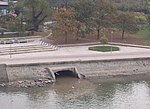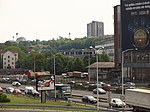BIGZ building
Buildings and structures in BelgradeCommercial buildings completed in 1941Cultural centersInstances of Lang-sr using second unnamed parameterSavski Venac

The BIGZ building (Serbian: Зграда БИГЗ-а, romanized: Zgrada BIGZ-a) is a building located in Belgrade, the capital of Serbia. Designed by Dragiša Brašovan, it is one of the most representative architectural landmarks of Serbian modern architecture. A monumental building, with its position, volume and aesthetics, it dominates the entrance in the southern section of Belgrade.It has been protected since 1992. In recent times it represents a significant cultural, artistic and social spot.
Excerpt from the Wikipedia article BIGZ building (License: CC BY-SA 3.0, Authors, Images).BIGZ building
Bulevar vojvode Misica, Belgrade Београд (Савски венац) (Savski Venac Urban Municipality)
Geographical coordinates (GPS) Address External links Nearby Places Show on map
Geographical coordinates (GPS)
| Latitude | Longitude |
|---|---|
| N 44.796911 ° | E 20.446263 ° |
Address
Зграда БИГЗ-а
Bulevar vojvode Misica 17
11000 Belgrade, Београд (Савски венац) (Savski Venac Urban Municipality)
Central Serbia, Serbia
Open on Google Maps







